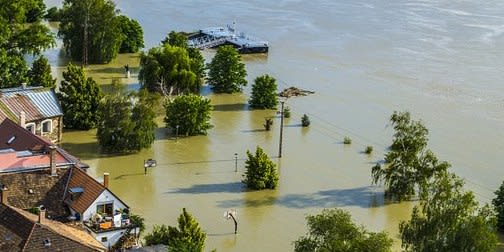Flood Preparedness
Flooding is the most common natural disaster in the United States and can happen anywhere. Flooding is an overflowing of water onto land that is normally dry. Flooding may happen with only a few inches of water, or it may cover a house to the rooftop. Flooding can occur during any season, but some areas of the country are at greater risk at certain times of the year. Coastal areas are at greater risk for flooding during hurricane season (i.e., June to November), while the Midwest is more at risk in the spring and during heavy summer rains. Ice jams occur in the spring in the Northeast and Northwest. Even the deserts of the Southwest are at risk during the late summer monsoon season.
The best way to stay safe is to leave areas that flood and avoid floodwaters.
The best way to stay safe is to leave areas that flood and avoid floodwaters.

1
Personal property
EVACUATE: To avoid being trapped when floodwaters threaten your area, the best action to protect yourself and your family is to evacuate before flooding starts
2
Property protection
Your goal now, before a flood occurs, is to reduce the risk of damage to structures from flooding. This means elevating critical utilities, such as electrical panels, switches, sockets, wiring, appliances, and heating systems, and waterproofing basements. In areas with repetitive flooding, consider elevating the entire structure.
3
Flood Insurance
Purchasing flood insurance provides financial protection for the cost of repairs due to flood damage. Standard insurance policies do not cover flooding, but flood insurance is available for homeowners, renters, and business owners through the National Flood Insurance Program.
4
Be Prepared
- Know your flood risk: . Learn whether you live, work, or travel through areas that are prone to flooding.
- Know how to stay informed. Get to the alerts notifications.
- Know your evacuation routes; plan your transportation and a place to stay.
5
Practice
Practice how you will communicate with family members. Simulate your emergency scenarios with every members in your household. Include your pets also.
6
Store
Store supplies so you can grab them quickly if you need to evacuate; know in advance what else you will need to take.
7
Document
Take photos of your important papers and documents. If necessary, seal important documents in a waterproof container (plastic etc).